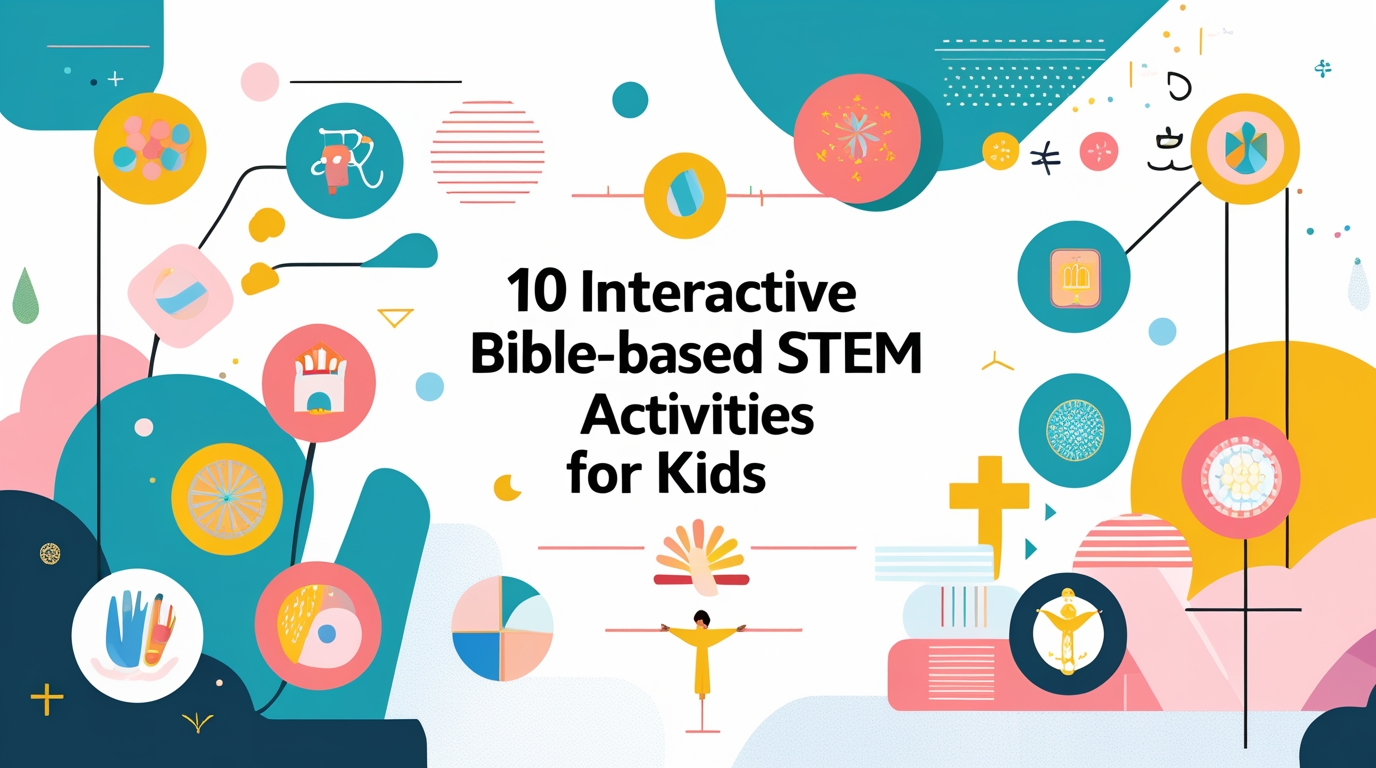In today’s high-tech world, children are immersed in STEM (Science, Technology, Engineering, and Mathematics) concepts from an early age. Yet, many parents and church educators want to ensure that these learning opportunities are anchored in biblical truth. By merging faith with science, kids can discover that God’s Word and the wonders of His creation go hand in hand.
This article provides 10 engaging, Bible-based STEM activities that encourage curiosity, creativity, and spiritual growth. Each activity is designed to be fun, hands-on, and easily adapted to various age groups. Whether you’re a homeschooling parent, a Sunday school teacher, or a church ministry leader, these ideas can help bridge the gap between faith and modern science.
1. Creation Science: Exploring God’s Masterpiece
Activity Overview:
This activity invites kids to explore the wonders of creation through hands-on science experiments. It emphasizes that the universe is a reflection of God’s creative power.
Materials Needed:
- A variety of natural objects (leaves, rocks, flowers)
- A magnifying glass
- A notebook and pencil for observations
- Internet access or a Bible for reference (Genesis 1)
Steps:
- Nature Walk and Observation:
Take a walk with your children in a local park or garden. Ask them to collect interesting natural objects and observe their details with a magnifying glass. - Discussion on Creation:
Read Genesis 1 together, discussing how each element of creation reflects God’s design and creativity. - Science Experiment:
Use a simple microscope or magnifying glass to examine the textures and structures of leaves and flowers. Discuss how complexity in nature points to a Creator. - Document Findings:
Have the kids draw or write about what they see. Encourage them to include questions about how these natural designs work.
Biblical Connection:
Genesis 1:1, “In the beginning, God created the heavens and the earth,” sets the foundation for understanding that science reveals the intricate details of God’s creation.
Learning Outcome:
Kids will enhance their observational and analytical skills while deepening their appreciation for the natural world as a testament to God’s artistry.
2. Noah’s Ark Engineering Challenge
Activity Overview:
Inspired by the story of Noah’s Ark, this challenge involves building a model ark using everyday materials. It teaches basic engineering principles and the importance of obedience and faith.
Materials Needed:
- Popsicle sticks or straws
- Glue or tape
- Cardboard base
- Small animal figurines (optional)
- Construction paper or markers for decoration
Steps:
- Story Time:
Read the story of Noah and his Ark (Genesis 6–9). Discuss the challenges Noah faced and the importance of trusting God. - Design Discussion:
Ask the children how they would design an ark to survive a flood. Encourage them to think about balance, structure, and space. - Building the Ark:
Using popsicle sticks or straws and glue, have the kids build a model ark on a cardboard base. They can design multiple levels or compartments for the animals. - Decoration and Reflection:
Let the kids decorate their ark with construction paper and markers. Once completed, discuss how careful planning and following God’s instructions led to Noah’s survival.
Biblical Connection:
Noah’s story (Genesis 6:14-16) demonstrates that following God’s design—no matter how unconventional it may seem—leads to salvation and new beginnings.
Learning Outcome:
This hands-on project improves fine motor skills and introduces engineering concepts while reinforcing lessons about obedience, planning, and God’s faithfulness.
3. Rainbow Science: A Covenant of Promise
Activity Overview:
Using simple materials, kids can create a rainbow—a beautiful reminder of God’s covenant with Noah. This activity links natural phenomena with biblical promises.
Materials Needed:
- A glass of water
- A white sheet of paper
- A flashlight or sunlight
- A prism (optional)
Steps:
- Set the Scene:
Read Genesis 9:13-17 about God’s promise and the rainbow as a sign of His covenant. - Rainbow Creation:
Fill a glass with water and place it on a white sheet of paper near a window or under a flashlight. Adjust the angle until a rainbow appears on the paper. If you have a prism, shine the light through it to see the spectrum. - Observation and Discussion:
Discuss the science behind rainbows—the refraction of light—and connect it to the promise of God. Ask the kids how the rainbow reminds them of God’s faithfulness. - Art Integration:
Encourage children to draw their own rainbows and write down what God’s promise means to them.
Biblical Connection:
The rainbow in Genesis is a symbol of God’s mercy and His everlasting covenant with all creation.
Learning Outcome:
This activity teaches basic optics while deepening the understanding of biblical promises and God’s unchanging love.
4. Biblical Botany: The Tree of Life Project
Activity Overview:
This project involves creating a “Tree of Life” using both art and science, where kids learn about plant biology and the symbolism of the tree in Scripture.
Materials Needed:
- Paper, markers, and crayons
- Real leaves or flower petals
- Glue
- A Bible for reference (Proverbs 3:18; Revelation 22:2)
Steps:
- Introduction to the Tree of Life:
Explain the concept of the Tree of Life as seen in the Bible (Revelation 22:2) and its symbolism for eternal life and God’s nourishment. - Nature Collection:
Take a short walk to collect various leaves or petals. Discuss how different plants thrive and contribute to the environment. - Art and Science Integration:
Have the children create a large tree on paper, using their collected leaves to form the branches. Ask them to label parts of the tree (roots, trunk, branches, leaves) and discuss how each part works together. - Spiritual Reflection:
Reflect on Proverbs 3:18, “She is a tree of life to those who take hold of her; those who hold her fast will be blessed.” Discuss how, like a tree, our lives are nourished by God’s Word.
Biblical Connection:
The Tree of Life is a recurring symbol in Scripture, representing sustenance, eternal life, and God’s wisdom.
Learning Outcome:
Children learn about plant biology and the interdependence of natural systems while also reflecting on spiritual nourishment and growth in Christ.
5. Math in the Bible: Counting Blessings
Activity Overview:
This activity helps kids integrate basic math skills with biblical stories, using numbers to explore themes of abundance and God’s provision.
Materials Needed:
- A Bible
- Counting objects (e.g., beads, coins, or small toys)
- Paper and pencil
Steps:
- Scripture Reading:
Choose a Bible passage that includes numbers—such as the 153 fish in John 21:11. Read the passage together and discuss its meaning. - Counting Exercise:
Use beads or coins to recreate the number mentioned in the Scripture. For example, count out 153 beads and discuss what that number could symbolize. - Math Challenge:
Create simple math problems based on the story. For instance, if 153 fish were caught and 100 were given away, how many remain? Encourage the kids to solve the problems. - Reflection:
Discuss how numbers in the Bible often carry deep meaning. Ask the children what they think numbers reveal about God’s abundance and faithfulness.
Biblical Connection:
Numbers in the Bible are more than mere figures—they often represent completeness, order, and divine provision.
Learning Outcome:
Kids will strengthen their math skills while gaining a deeper understanding of biblical numerology and the ways numbers can symbolize God’s blessings.
6. Engineering the Bible: Building a Miniature Solomon’s Temple
Activity Overview:
Inspired by the intricate design of Solomon’s Temple, this activity allows kids to explore basic engineering principles while learning about biblical architecture and worship.
Materials Needed:
- Cardboard or foam board
- Scissors, glue, and tape
- Construction paper for decoration
- Ruler and pencil
Steps:
- Biblical Background:
Provide a brief history of Solomon’s Temple (1 Kings 6-7). Discuss the significance of the temple as a place of worship and a symbol of God’s presence. - Design Phase:
Ask the kids to draw a simple blueprint for a miniature temple. Encourage them to consider elements like walls, a roof, and decorative details. - Construction:
Using cardboard or foam board, help the children build their miniature temple according to their design. Allow time for creativity in decorating with construction paper. - Reflection:
Discuss how architecture can be a form of worship and how the temple symbolizes our hearts being a dwelling place for God.
Biblical Connection:
Solomon’s Temple is a powerful symbol of God’s glory and the importance of worship, reminding believers that our bodies and lives should be holy temples for the Holy Spirit (1 Corinthians 6:19).
Learning Outcome:
Children will learn basic engineering and design skills while engaging with biblical history and the concept of sacred space.
7. Coding with a Christian Twist: Simple Bible Story Games
Activity Overview:
Introduce kids to the basics of coding by creating simple games or interactive stories based on Bible narratives. This activity blends technology with biblical storytelling.
Materials Needed:
- A computer or tablet
- Free coding platforms (e.g., Scratch, Code.org)
- Bible stories for inspiration (e.g., David and Goliath, Jonah and the Whale)
Steps:
- Choose a Bible Story:
Let the kids select a favorite Bible story that can be adapted into a game or interactive narrative. - Learn Basic Coding:
Introduce them to a beginner-friendly coding platform like Scratch. Show them how to create simple animations or interactive elements. - Create the Game:
Guide the kids in designing a simple game—such as a quiz on Bible trivia or an interactive story where choices affect the outcome. Encourage creativity in how the story is told. - Share and Reflect:
Have the kids present their projects to the family or class. Discuss how technology can be used to share the timeless messages of the Bible.
Biblical Connection:
Just as God is the ultimate Creator, teaching children to create through coding instills the understanding that creativity and innovation are gifts from God. Reflect on Genesis 1:1 as you create something new.
Learning Outcome:
This activity introduces basic coding skills while fostering creativity and a deeper connection to biblical narratives. Kids learn that technology can be a tool for storytelling and spreading God’s word.
8. Weather Wonders: Studying God’s Creation Through Storm Experiments
Activity Overview:
Explore the science behind weather phenomena by conducting simple experiments that mimic stormy conditions. This activity helps kids appreciate the power and intricacy of God’s creation.
Materials Needed:
- A glass of water
- Ice cubes
- A hairdryer
- A bowl and some food coloring
- A Bible for reference (Job 38:22)
Steps:
- Introduction to Weather:
Discuss different types of weather and their impact on our world. Read Job 38:22, where God asks, “Have you entered the storehouses of the snow, or have you seen the storehouses of the hail?” to spark curiosity. - Simple Experiment – Creating a Storm:
Fill a bowl with water, add a few drops of food coloring, and place ice cubes on top. Use a hairdryer on a low setting to simulate wind. Observe how the food coloring swirls as if stirred by a storm. - Discussion:
Explain the basic science of weather formation and discuss how God’s creative power is evident in the natural world. - Art and Science Integration:
Encourage kids to draw or write about the experiment and how it reminds them of the awe-inspiring nature of God’s creation.
Biblical Connection:
Psalm 107:29 highlights God’s power over the weather, “He stilled the storm to a whisper; the waves of the sea were hushed.” This verse reinforces the idea that God is in control of even the most powerful forces of nature.
Learning Outcome:
Kids will gain an understanding of basic weather science while deepening their appreciation for the power and order of God’s creation.
9. Gravity and Motion: The Miraculous Movement of Creation
Activity Overview:
Explore the principles of gravity and motion by conducting experiments that demonstrate how objects move. Relate these scientific principles to the biblical narrative of creation and God’s sustaining power.
Materials Needed:
- A small ball or toy
- A ramp (a piece of cardboard works well)
- Measuring tape
- Stopwatch
- Bible for reference (Hebrews 1:3)
Steps:
- Set Up the Experiment:
Create a simple ramp using a piece of cardboard. Let the kids roll the ball down the ramp and measure how fast it travels. - Discuss Gravity and Motion:
Explain the basic principles of gravity and motion. Relate this to the Bible by discussing Hebrews 1:3, which says that Christ sustains all things by His powerful word. - Challenge:
Have the children modify the ramp’s angle or surface and observe how the ball’s speed changes. Encourage them to record their observations. - Reflection:
Discuss how God’s power holds everything together, from the movement of the stars to the fall of a simple ball.
Biblical Connection:
This experiment can remind children that just as gravity governs motion in the physical world, God’s power governs every aspect of our lives. It’s a tangible demonstration of divine order in nature.
Learning Outcome:
Through this activity, kids learn the basics of physics while drawing parallels between scientific principles and biblical truths about God’s sustaining power.
10. Water Science: Exploring Miracles and Covenant
Activity Overview:
Water plays a significant role in the Bible—from the cleansing in baptism to the covenant symbolized by the rainbow. This activity explores the properties of water through experiments that tie into biblical themes.
Materials Needed:
- Clear plastic cups
- Water
- Food coloring
- Salt
- Stirring utensil
- A Bible for reference (John 4:14)
Steps:
- Water and Reflection:
Begin by discussing the importance of water in the Bible, such as Jesus’ conversation with the Samaritan woman in John 4. - Experiment – Dissolving Salt:
Have the kids observe what happens when salt is added to water. Discuss how water can transform substances and act as a symbol of cleansing and renewal. - Experiment – Color Mixing:
Add different food colorings to water and observe how they mix. Relate this to the idea of unity and diversity in God’s creation. - Discussion:
Reflect on the symbolism of water in baptism and the promise of the new covenant. How does this simple substance represent God’s transformative power?
Biblical Connection:
John 4:14 states, “But whoever drinks the water I give them will never thirst.” This verse speaks to the eternal satisfaction that only God can provide—a theme that resonates deeply in the act of water-based experimentation.
Learning Outcome:
Kids will discover basic principles of dissolution and mixing while connecting these scientific observations to the transformative, life-giving nature of God’s word.
Final Thoughts
Integrating STEM activities with biblical principles offers a dynamic and holistic approach to learning. These 10 Bible-based STEM activities are designed to spark curiosity, encourage hands-on learning, and deepen children’s understanding of both science and Scripture. By participating in these projects, kids not only gain valuable STEM skills but also discover that God’s creative power is evident in every facet of the world around them.
Each activity provides an opportunity to see God’s fingerprints on nature—from the intricate details of plant life to the laws that govern the universe. When children learn that science and faith are not mutually exclusive but rather complementary, they are empowered to explore the world with both wonder and wisdom.
Tips for Parents and Educators
- Create a Supportive Environment:
Set aside a dedicated space where children can engage in these activities without distraction. A corner of the classroom or a home study area can work wonders. - Encourage Inquiry:
Allow children to ask questions and explore the “why” behind each experiment. Engage in discussions that connect the science to biblical truths. - Document the Journey:
Keep a journal or portfolio of these projects. Not only will this reinforce learning, but it also creates a wonderful record of growth and discovery that can be shared with family and church groups. - Integrate Devotionals:
Consider beginning or ending each activity with a short devotional that focuses on God’s creativity and the wonder of His creation. This practice can further deepen the spiritual connection. - Celebrate Creativity:
Encourage children to share their projects with others. Whether it’s a science fair at church or a simple display at home, celebrating their work reinforces the value of creativity in both science and faith.
Conclusion
Bible-based STEM activities for kids provide a unique opportunity to integrate faith with learning in a fun and engaging way. By exploring the principles of science through the lens of Scripture, children gain a balanced perspective that honors both God and the natural world He created. These activities not only enhance critical thinking and problem-solving skills but also nurture a lifelong curiosity and love for God’s creation.
As you incorporate these 10 activities into your teaching or parenting routine, you’ll find that the lessons extend far beyond scientific concepts. They instill values of creativity, obedience, and wonder—qualities that mirror the heart of the gospel. In a world where children are constantly bombarded with information, these hands-on experiences remind them that true wisdom comes from understanding both the natural and spiritual realms.
May these Bible-based STEM activities ignite a passion for learning and a deep respect for God’s ingenious design. Happy exploring, and may every experiment reveal a little more of the Creator’s marvelous work!
If you have additional Bible-based STEM activity ideas or experiences to share, please leave a comment below. Your insights can inspire others to see the beauty of integrating faith with science.



